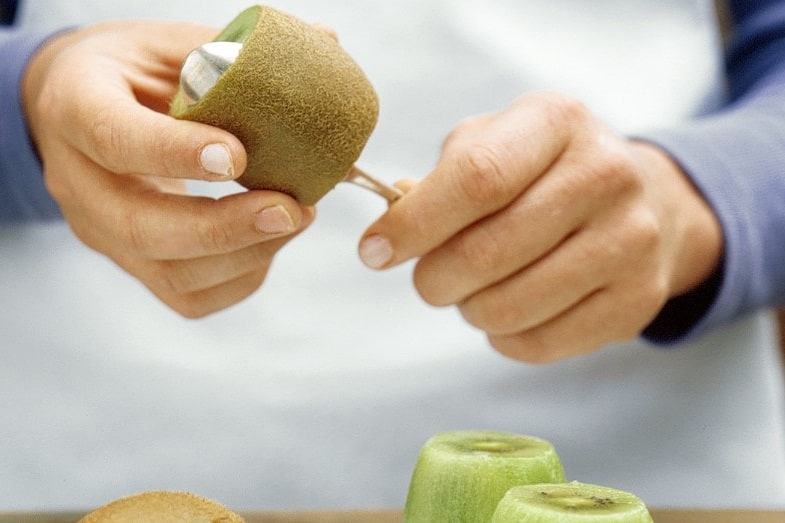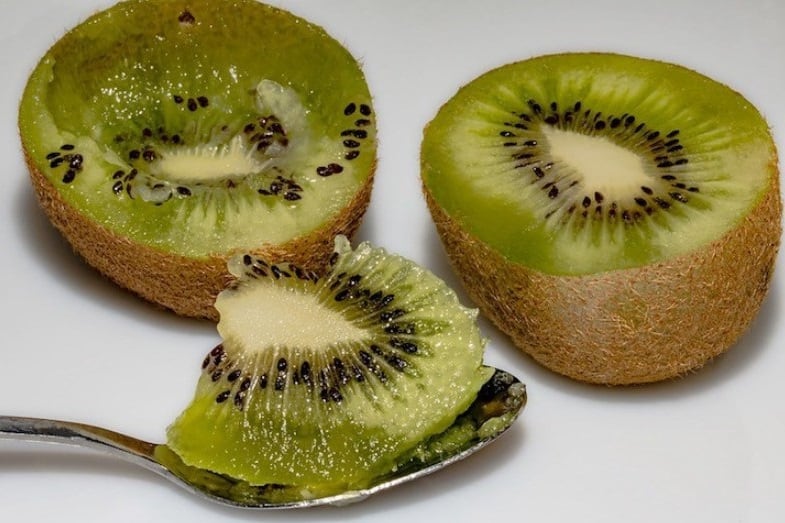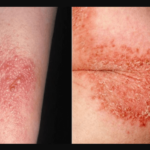Most people know that kiwi, like many other fruits, has beneficial vitamins and nutrients; however, not everyone knows how to eat this small, green, and furry fruit. One of the most common questions is whether one can eat the peel or not. Should you peel it? Can you eat kiwi skin? Is it harmful?
The answer may be shocking, especially for people who are accustomed to peeling fruits like mangoes, oranges, bananas, and the like.
Can you eat kiwi skin? According to the California Kiwifruit Commission, it is not only safe to eat the kiwi skin, but it has many beneficial nutrients. Kiwi is packed full of nutrients and fiber, and most of its antioxidant content is present in its skin. By eating kiwi skin, the nutrient intake of the fruit is increased by 30 to 50 percent. So the kiwi skin is absolutely edible, and it makes the already nutrient-dense fruit even more nutritious!
Eating kiwi skin might be a bit off-putting at first due to its furry texture. It can even be an unpleasant experience for some. However, the benefits of eating kiwi skin together with its fruit are immense. Plus, you need not go through the hassle of peeling! Just wash and eat!
Still not convinced? Read on to know more about the kiwi fruit and its benefits and to know whether it’s safe to eat kiwi skin.
Can You Eat Kiwi Skin? Is It Harmful?
The kiwi fruit may not be the best and most tasty fruit around. From its weird-looking, fuzzy exterior to its soft, bright green fruit on the inside, most people tend to dwell more on its weird look rather than its enticing taste.
Like most other fruits, the kiwi has its positive and slightly negative characteristics, depending on who you ask. The diversity of people around the world proves that not everyone can consume exotic fruits like kiwi. Most people enjoy its unique flavor profile and texture, including its fuzzy brown skin. However, some people may have slight allergic reactions after consuming it.
Benefits of Eating Kiwi Skin

The benefits of eating kiwi outweigh its strange appearance, that’s for sure. Here is a list of kiwi fruit benefits, whether you consume its skin or not:
- Improved Digestion and Reduced Constipation – Kiwi fruits contain a significant amount of fiber found in its flesh and skin.
- Better Immunity – Eating kiwi can help reduce the risks of developing a sore throat and head congestion.
- Lower Cholesterol Levels – Including two pieces of kiwi in your diet for eight weeks can help boost antioxidant levels in the blood, increase the heart-healthy HDL cholesterol levels while lowering critical oxidation of LDL cholesterol.
- Lower Blood Pressure – Regular consumption of kiwi has shown to help lower blood pressure in a span of eight weeks.
Erica Julson, a registered dietitian, sums it up perfectly in her 2018 article for Healthline Media. She said that kiwi skin is, in fact, edible and is full of nutrients. She also shared that kiwi skin has high concentrations of folate, vitamin E, and fiber, which are all essential for our health.
- Vitamin E – Keeps the cells healthy by preventing damage from free radicals.
- Fiber – Helps lower the risks associated with heart disease, cancer, and diabetes.
- Folate – Promotes cell growth and is an essential nutrient for pregnant women.
Since most of us do not actually consume enough nutrients in our diet, consuming a fair amount of kiwi fruit, among other fruits and vegetables, can help boost our nutrient intake. Eating kiwi skin increases fiber intake by 50%, folate by 32%, and vitamin E by 34% as compared to eating the fruit’s flesh alone.
Kiwi Fruit Facts
Here are other fast facts about the strange-looking kiwi fruit you might not know about:
- Consuming kiwi fruit helps protect against cancer and assists in the repair of DNA.
- Kiwi has almost twice the amount of vitamin C in an orange. A serving of kiwi fruit can provide 230% of the US recommended daily allowance for vitamin C.
- Kiwi can help in asthma relief.
- Kiwi is a better alternative to bananas for a low-sodium, high-potassium diet.
- Kiwi is a low-fat source of vitamin E, better than the calorie-heavy avocado.
To better understand, here is a table showing the amounts of specific nutrients you’ll get from one kiwi fruit (69 g). This data is from the US Department of Agriculture (USDA) published on April 1, 2019. The table below also includes the daily adult nutrient requirement according to the 2015-2019 Dietary Guidelines for Americans: [1]
| Nutrient | Amount in 1 Kiwi (69 g) | Daily Adult Requirement |
| Energy (calories) | 42.1 | 1,600–3,000 |
| Carbohydrates (g) | 10.1, including 6.2 g of sugar | 130 |
| Fiber (g) | 2.1 | 22.4–33.6 |
| Calcium (mg) | 23.5 | 1,000–1,300 |
| Magnesium (mg) | 11.7 | 310–420 |
| Phosphorus (mg) | 23.5 | 700–1,250 |
| Potassium (mg) | 215 | 4,700 |
| Copper (mcg) | 90 | 890–900 |
| Vitamin C (mg) | 64 | 65–90 |
| Folate (mcg) | 17.2 | 400 |
| Beta Carotene (mcg) | 35.9 | No data |
| Lutein & Zeaxanthin (mcg) | 84.2 | No data |
| Vitamin E (mg) | 1.0 | 15 |
| Vitamin K (mcg) | 27.8 | 75–120 |
As you can see, kiwi is full of vitamins and minerals that are essential in keeping our bodies in tip-top shape. Aside from all this, kiwi also contains trace amounts of iron and vitamin A.
Can Eating Kiwi Skin Harm You? Risks of Eating Kiwi Skin
Despite the beneficial effects of consuming kiwi, some people still prefer not to eat kiwi skin or the whole fruit, for that matter. Why? Some of the more common reasons are due to the weirdness of its appearance.
Due to its fuzzy exterior, some may find it easier just to eat the flesh and discard the skin. Kiwi skin can also irritate some people due to the presence of raphides, which are naturally occurring calcium oxalate crystals that can easily scratch the linings inside the mouth. And since the fruit is acidic, it can cause an unpleasant stinging sensation when the acid hits the microscopic tears inside the mouth.
Can eating kiwi skin while pregnant be harmful? Kiwi is a good source of folate. Folate is beneficial for cognitive development and the brain. Folate in kiwi also helps and defend against neural defects in babies. It helps prevents neural defects in babies both during and before pregnancy. So the folate in kiwi is essential for pregnant women. So kiwi skin is great to eat while pregnant!
Other than the strangeness of its appearance and people’s preferences, it seems that kiwi is an overall good fruit. But there are just certain types of people who should never consume kiwi fruits. They include those with the following conditions:

1. Kiwi Fruit Allergy
Symptoms include a slightly itchy mouth to extreme anaphylaxis. These symptoms occur when the immune system reacts to the kiwi fruit’s specific proteins.
2. Kidney Problems
People with a medical history of calcium oxalate kidney stones must avoid eating kiwi skin since it has a higher concentration of oxalates than the flesh of the fruit.
Kiwi fruit, having a significant amount of potassium, must be taken out or regulated from the diet of a person with kidney problems or those who are taking beta-blockers for heart health.
3. Heart Ailments
According to Medical News Today, some nutrients in kiwi can cause adverse effects to people taking certain medications, such as beta-blockers and blood thinners. These medications are usually prescribed to people who are at risk for cardiovascular disease or events. Consuming a lot of kiwi fruit may interfere with the intended effects of these medications.
Beta-blockers are used to reduce the body’s “fight-or-flight” response, and in turn, reduces stress in certain parts of our body, such as the brain and heart. But taking beta-blockers can also increase the potassium levels in the blood, which can cause serious side effects. The same goes for people with kidney problems.
Blood thinners similarly help in the reduction of the risks of heart disease. But it cannot work as intended if taken with a diet containing considerable amounts of vitamin K. Kiwi fruit is rich in vitamin K, which is an important nutrient in blood clotting, regulation of blood calcium, and bone metabolism.
So can you eat the skin of a kiwi? Yes, you can eat the skin; however, just be aware of the above possible ways eating kiwi skin could be harmful. Ask your doctor before increasing your kiwi fruit intake, especially if you are monitoring your heart health.
Kiwi Fruit Origins: What Is It and Where Did It Come From?
To be completely holistic in our knowledge about the kiwi fruit and the kiwi skin, we must first discuss its origins. Most of us already know that kiwifruit or kiwi is New Zealand’s national fruit, famed and named for its resemblance to the country’s national bird, the kiwi. They say that if you want to be a true local, you should call it kiwifruit. But did you know that the kiwi is not native to New Zealand? Surprise, surprise!
The origins of the kiwi fruit started many centuries ago in the Far East, having been cultivated in what is now known as modern-day China. As written in the Compendium of Materia Medica (16th-century Chinese medicine encyclopedia), its original Chinese term is míhóutáo, which translates to macaque fruit because monkeys love eating kiwi. Not much is written about the fruit’s history, and this account telling its original name is probably one of the only few.
Since there really is no formal history of the kiwi fruit and its industry available in print, researchers and academics needed to stitch together different accounts from multiple sources.
One of these academics is Professor Hugh Campbell of the University of Otago in New Zealand. He tells TIME Magazine in 2017 [2] that there’s a consensus on how and when the first seeds of the kiwi fruit arrived on their shores. It was during the turn of the 20th century when the kiwi fruit was first introduced to New Zealand.
Here’s a rundown of events:
- A school principal named Mary Isabel Fraser brought back some Chinese gooseberry seeds from her travels in 1904.
- These seeds were then given to Alexander Allison, a farmer, who, of course, planted the seeds in his farm near the town of Whanganui.
- It took about six years for the trees to bear fruit in 1910.
- Around this same time, the US and UK were also experimenting on the fruit species in the hope of making it their commercial crop. But luck must have been on New Zealand’s side as cultivations in other parts of the world turned out to be inedible.
- According to New Zealand’s official history, the rebranding of Chinese gooseberries to kiwifruits did not happen until 50 years after the first trees in Allison’s farm bore fruit.
- The first kiwifruits were exported to US shores by Turners and Growers on June 15, 1959.
Did you know that the kiwi was supposed to be internationally known as melonette? It was to avoid the hugely unpopular term gooseberries, which at that time also had negative connotations.
After a few more discussions between country trade partners, it was finally decided to just name the new commercially viable fruit after New Zealand’s cute, furry, and brown flightless national bird. It was also the start of using the term Kiwis as the colloquial term for people from New Zealand.
The kiwi fruit indeed has a very colorful history surrounded by political and highly scientific aspects. Now that we know its history, let us talk about the benefits and possible health risks of eating the kiwi fruit.
Conclusion – Can You Eat Kiwi Skin? Is it Harmful?
So to revisit our initial questions: Can you eat kiwi skin? Is eating kiwi skin harmful? Yes, you can certainly eat kiwi skin. According to the California Kiwifruit Commission, it is safe to eat kiwi skin, and the kiwi skin has many beneficial nutrients. Kiwi is packed full of fiber and nutrients, and most of its antioxidant content is present in its skin.
By eating kiwi skin, the nutrient intake of the fruit is increased by 30 to 50 percent. So the kiwi skin makes the already nutrient-dense fruit even more nutritious!
Despite the good, the bad, and the ugly sides of the kiwi fruit, it can still be considered as one of the best sources of essential vitamins and minerals for the body. While everyone cannot consume it, it does not change the fact that it is a delicious and nutritious natural food source.


![Neutral Skin Tone Defined [and Best Colors for Neutral Skin] neutral skin tone](https://skincaregeeks.com/wp-content/uploads/2021/05/neutral-skin-tone-150x150.png)






